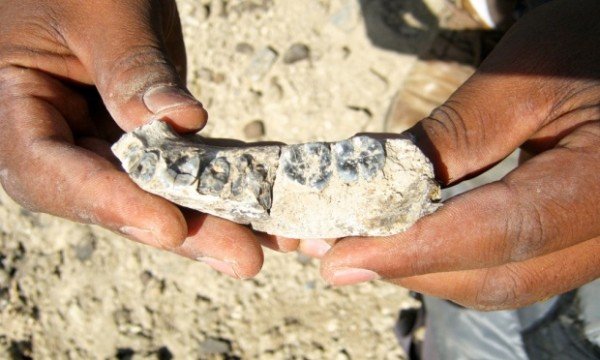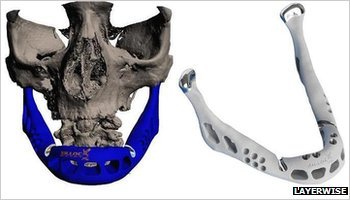A fossilized jawbone of what scientists claim is one of the very first humans has been discovered un Ethiopia.
The 2.8 million-year-old specimen is 400,000 years older than researchers thought that our kind first emerged.
The discovery suggests climate change spurred the transition from tree dweller to upright walker.
Prof. Brian Villmoare of the University of Nevada in Las Vegas said the discovery makes a clear link between an iconic 3.2 million-year-old hominin (human-like primate) discovered in the same area in 1974, called “Lucy”.
The fossil record between the time period when Lucy and her kin were alive and the emergence of Homo erectus (with its relatively large brain and humanlike body proportions) two million years ago is sparse.
The 2.8 million-year-old lower jawbone was found in the Ledi-Geraru research area, Afar Regional State, by Ethiopian student Chalachew Seyoum.
The fossil is of the left side of the lower jaw, along with five teeth. The back molar teeth are smaller than those of other hominins living in the area and are one of the features that distinguish humans from more primitive ancestors, according to Prof. William Kimbel, director of Arizona State University’s Institute of Human Origins.
A computer reconstruction of a skull belonging to the species Homo habilis, which has been published in Nature journal, indicates that it may well have been the evolutionary descendant of the species announced today.
The dating of the jawbone might help answer one of the key questions in human evolution. What caused some apes to climb down from the trees and make their homes on the ground.
A separate study in Science hints that a change in climate might have been a factor. An analysis of the fossilized plant and animal life in the area suggests that what had once been lush forest had become dry grassland.
As the trees made way for vast plains, apes found a way of exploiting the new environmental niche, developing bigger brains and becoming less reliant on having big jaws and teeth by using tools.
According to scientists, there were several different species of humans co-existing in Africa around two million years ago with only one of them surviving and eventually evolving into our species, Homo sapiens. It is as if nature was experimenting with different versions of the same evolutionary configuration until one succeeded.
A lower jaw created by a 3D printer has been fitted to an 83-year-old woman’s face in what doctors say is the first transplant of its kind.
The transplant was carried out in June in the Netherlands, but is only now being publicized.
The implant was made out of titanium powder – heated and fused together by a laser, one layer at a time.
Technicians say the operation’s success paves the way for the use of more 3D-printed patient-specific parts.
The surgery follows research carried out at the Biomedical Research Institute at Hasselt University in Belgium, and the implant was built by LayerWise – a specialized metal-parts manufacturer based in the same country.
The patient involved had developed a chronic bone infection. Doctors believed reconstructive surgery would have been risky because of her age and so opted for the new technology.

A lower jaw created by LayerWise 3D printer has been fitted to an 83-year-old woman's face in what doctors say is the first transplant of its kind
The implant is a complex part – involving articulated joints, cavities to promote muscle attachment and grooves to direct the regrowth of nerves and veins.
However, once designed, it only took a few hours to print.
“Once we received the 3D digital design, the part was split up automatically into 2D layers and then we sent those cross sections to the printing machine,” said Ruben Wauthle, LayerWise’s medical applications engineer.
“It used a laser beam to melt successive thin layers of titanium powder together to build the part.
“This was repeated with each cross section melted to the previous layer. It took 33 layers to build 1mm of height, so you can imagine there were many thousand layers necessary to build this jawbone.”
Once completed, the part was given a bioceramic coating. The team said the operation to attach it to the woman’s face took four hours, a fifth of the time required for traditional reconstructive surgery.
“Shortly after waking up from the anaesthetics the patient spoke a few words, and the day after the patient was able to swallow again,” said Dr. Jules Poukens from Hasselt University, who led the surgical team.
“The new treatment is a world premiere because it concerns the first patient-specific implant in replacement of the entire lower jaw.”
The woman was able to go home after four days.
Her new jaw weighs 107 g, just over a third heavier than before, but the doctors said that she should find it easy to get used to the extra weight.
Follow-up surgery is scheduled later this month when the team will remove healing implants inserted into holes built into the implant’s surface.
A specially made dental bridge will then be attached to the part, following which false teeth will be screwed into the holes to provide a set of dentures.
The team said that it expected similar techniques to become more common over the coming years.
“The advantages are that the surgery time decreases because the implants perfectly fit the patients and hospitalization time also lowers – all reducing medical costs,” said Ruben Wauthle.
“You can build parts that you can’t create using any other technique. For example you can print porous titanium structures which allow bone in-growth and allow a better fixation of the implant, giving it a longer lifetime.”
The research follows a separate project at Washington State University last year in which engineers demonstrated how 3D-printer-created ceramic scaffolds could be used to promote the growth of new bone tissue.
They said experiments on animals suggested the technique could be used in humans within the next couple of decades.
LayerWise believes the two projects only hint at the scope of the potential medical uses for 3D printing.
Ruben Wauthle said that the ultimate goal was to print body organs ready for transplant, but cautioned that such advances might be beyond their lifetimes.
“There are still big biological and chemical issues to be solved,” he said.
“At the moment we use metal powder for printing. To print organic tissue and bone you would need organic material as your <<ink>>. Technically it could be possible – but there is still a long way to go before we’re there.”


